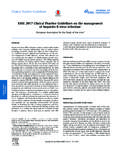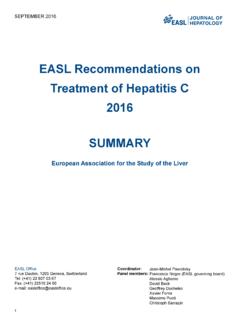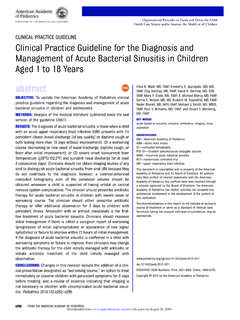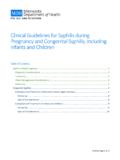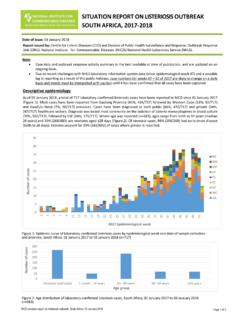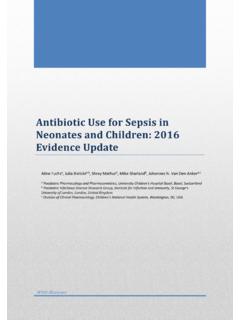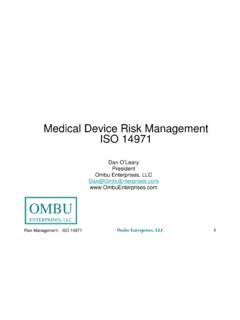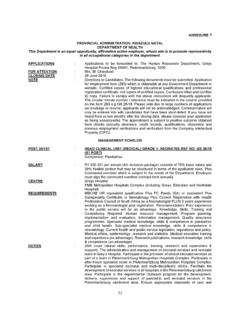Transcription of EASL Clinical Practical Guidelines on the …
1 EASL Clinical Practical Guidelines on the managementof acute (fulminant) liver failureqEuropean Association for the Study of the Liver SummaryThe term acute liver failure (ALF) is frequently applied as a gen-eric expression to describe patients presenting with or develop-ing an acute episode of liver dysfunction. In the context ofhepatological practice, however, ALF refers to a highly specificand rare syndrome, characterised by an acute abnormality of liverblood tests in an individual without underlying chronic liver dis-ease. The disease process is associated with development of acoagulopathy of liver aetiology, and clinically apparent alteredlevel of consciousness due to hepatic encephalopathy. Severalimportant measures are immediately necessary when the patientpresents for medical attention. These, as well as additional clini-cal procedures will be the subject of these Clinical practiceguidelines. 2016 European Association for the Study of the Liver. Publishedby Elsevier All rights term acute liver failure (ALF) is frequently applied as ageneric expression to describe patients presenting with ordeveloping an acute episode of liver dysfunction.
2 It is charac-terised by a deterioration in liver function tests, and poten-tially associated with dysfunction in other organs. ALF isfrequently, but often incorrectly used to describe both acutedeterioration in liver function in patients with chronic liverdisease (a condition that should be termed acute-on-chronicliver failure [AoCLF]), or liver involvement in systemic diseaseprocesses. Liver injury secondary to alcohol, which presentsas alcoholic hepatitis, and other forms of AoCLF, can be dif-ficult to distinguish from ALF on occasion. However, thereare clear differences, and different forms of managementare extensive liver resection, patients with or withoutunderlying chronic liver disease, may develop a clinicalsyndrome of jaundice, coagulopathy and hepatic encephalopa-thy (HE). The presentation is very similar to that of a post-transplant small for size syndrome scenario. These syndromesare not considered within the scope of ALF, but do feature insome ALF databases, such as the European Liver TransplantRegistry (ELTR).
3 Extensive liver trauma is also included in ALFdatabases, but is not a cause of ALF unless there is loss of bothvenous and arterial the context of hepatological practice, ALF refers to ahighly specific and rare syndrome, characterised by an acuteabnormality of liver blood tests in an individual without under-lying chronic liver disease. The disease process is associatedwith development of a coagulopathy of liver aetiology, asopposed to the coagulation disturbance seen in sepsis, and clin-ically apparent altered level of consciousness due to HE. Thecondition of patients who develop coagulopathy, but do nothave any alteration to their level of consciousness is definedas acute liver injury (ALI). Thus, the term ALF is appropriatelyused to describe patients who develop both coagulopathy andaltered mentation and will be the subject of these Clinical prac-tice features of coagulopathy, increased serum transaminases,abnormal bilirubin and altered levels of consciousness may beseen in patients with a variety of systemic disease , if there is no primary liver insult, these patients shouldbe considered to have a secondary liver injury and not ALF; man-agement should focus on the treatment of any underlying evidence and recommendations in these Guidelines havebeen graded according to the Grading of RecommendationsAssessment Development and Evaluation (GRADE) system[1].
4 The strength of recommendations reflects the quality of theunderlying evidence. The GRADE system offers two grades of rec-ommendation: strong (1) or weak (2) (Table 1). The CPGs thusconsider the quality of evidence: the higher the quality of evi-dence, the more likely a strong recommendation is warranted;the greater the uncertainty, the more likely a weaker recommen-dation is and main Clinical features of ALFThe Clinical course of ALF is initiated with a severe ALI. This ischaracterised by a two- to threetimes elevation of transaminases(as a marker of liver damage) associated with impaired liver func-tion, , jaundice and coagulopathy, in a patient without aJournal of Hepatology2017vol. 66j1047 1081 Received 7 December 2016; accepted 7 December 2016qClinical practice Guidelines panel:Chair: Julia Wendon; Panel members: JuanCordobay, Anil Dhawan, Fin Stolze Larsen, Michael Manns, Frederik Nevens, DidierSamuel, Kenneth J. Simpson, Ilan Yaron; EASL Governing Board representative:Mauro Bernardi Corresponding author.
5 Address: European Association for the Study of the Liver(EASL), The EASL Building The Home of European Hepatology, 7 Rue Daubin,1203 Geneva, Switzerland. Tel.: +41 (0) 22 807 03 60; fax: +41 (0) 22 328 07 Cordoba passed away during the preparation of this Practice Guidelineschronic liver disease. This Clinical description originated fromobservations of drug related hepatotoxicity, but is applicable toall presentations[2].ALF was originally defined by Trey and Davidson in 1970 asfulminant liver failure, which was a potentially reversible condi-tion, the consequence of severe liver injury, with an onset ofencephalopathy within 8 weeks of the appearance of the firstsymptoms and in the absence of pre-existing liver disease [3].In 1993, the syndrome was redefined to take into account theaetiology, frequency of complications and prognosis (Table 2)[4]. Considering jaundice as the first symptom, hyperacute liverfailure describes patients developing HE within 7 days of notingjaundice. Acute liver failure occurs when patients develop HEbetween 8 and 28 days of noting jaundice; and subacute liverfailure describes HE occurring within 5 12 weeks of jaundice(Fig.)
6 1). Disease duration of greater than 28 weeks before theonset of encephalopathy is categorised as chronic liver International Association for the Study of the Liver (IASL)sub-committee statement (1999) defined hyperacute ALF as lessthan 10 days, fulminant ALF as 10 days to 30 days and subacutehepatic failure as 5 to 24 weeks[7].Hyperacute presentations consist of severe coagulopathy,markedly increased serum transaminases and initially onlymoderate, if any, increase in bilirubin[8]. In contrast,subacute/subfulminant presentations often have a milderincrease in serum transaminases, deep jaundice and mild tomoderate coagulopathy[5,9]. It should be noted, however, thatserum transaminase levels may not be considered a fully reliableparameter for diagnosis. Patients with subacute ALF often alsohave splenomegaly, ascites, and a shrinking liver volume. OnceHE develops, these patients have a very low chance ofspontaneous survival. In contrast, hyperacute presentations havea much greater chance of spontaneous recovery, despite havingsignificant extrahepatic organ failure[10].
7 The disturbances to coagulation required to define ALF aredetermined by a prolongation of International NormalisedRatio (INR), usually > , or a prolongation of prothrombintime (PT)[11]. Although this remains, at present, theaccepted definition, it could be argued that a greater prolon-gation of INR should be required to define ALF. However, theINR is not standardised, and was designed to monitor war-farin therapy[12]. As a more accurate marker many clini-cians would now suggest prolongation of PT in the contextof the normal range for a particular laboratory. The otherdefining features of ALF, , jaundice and HE, are requiredto be clinically manifested. However, in very young childrenand neonates, ALF may occur in the absence of HE, albeitwith a definition that requires a much greater degree ofcoagulopathy (INR >4)[10]. Initial mental alterations maybe subtle and therefore should be actively sought. Effortshave been made to develop more sensitive measures todefine early grades of HE, but they are not available in rou-tine Clinical settings and certainly not in district hospitalswhere most patients first present for medical attention[13].
8 The concept of minimal HE is well recognised in patientswith cirrhosis, but is poorly characterised in patients withALF. Characterisation of minimal HE may be a useful toolin clarifying management plans for those with subacute pre-sentations, although less relevant to hyperacute and acuteALF presentations. In subacute liver failure, the presence ofHE usually occurs late in the disease course and is often amanifestation of infection; once HE develops the patient hasa very short window to obtain a liver transplant, if proposals suggest that in an appropriate Clinical con-text accompanied by a shrinking liver volume, super urgentlisting could be undertaken in this cohort, without the pres-ence of clinically clear encephalopathy. Even with a definitionset there are clear differences between acute and hyperacuteliver failure (which have similar phenotype and clinicalcourse), and subacute liver failure (which presents with a dif-ferent Clinical course). Separation of these two groups shouldbe considered in future guidance, regarding prognosis andclinical management prerequisite for defining cases of ALF is the absenceof previous severe fibrotic or cirrhotic chronic liver exceptions are the acutede novopresentation ofautoimmune hepatitis and Budd-Chiari syndrome.
9 In these con-ditions, an underlying chronic disease will not have beenrecognised or diagnosed previously, and there should be noclinical or histological evidence of cirrhosis. Wilson disease isanother exception category; a Clinical scenario when there isa clear chronic liver disease with splenomegaly, albeit fre-quently undiagnosed. The precipitant event is often a viralinfection,[14]or in adolescents, non-compliance with , these patients are considered as having ALF sincethey share the poor prognosis, a common Clinical picture ofacute failure of the liver, and present with significant coagu-lopathy and small group of patients whom frequently cause consterna-tion are those without overt fibrosis but with evidence of a liverpathology ( , metabolic syndrome and fatty liver, hepatitis C orB), who then develop an ALI. These patients may progress toencephalopathy, severe coagulopathy, and elevated serumtransaminases. In the context of a Clinical scenario, supportedby ultrasound and axial imaging of no overt fibrosis or portalhypertension these patients would normally be categorised evidence and recommendations (adapted from GRADE system).
10 Grade of evidenceIRandomized, controlled trialsII-1 Controlled trials without randomizationII-2 Cohort or case-control analytical studiesII-3 Multiple time series, dramatic uncontrolled experimentsIIIO pinion of respected authorities, descriptive epidemiologyGrade of recommendation1 Strong recommendation: Factors influencing the strength of therecommendation included the quality of the evidence, presumedpatient-important outcomes, and cost2 Weaker recommendation: Variability in preferences and values, ormore uncertainty: more likely a weak recommendation iswarranted. Recommendation is made with less certainty: highercost or resource consumptionClinical Practice Guidelines1048 Journal of Hepatology2017vol. 66j1047 1081 Recommendations Severe acute liver injury defines a syndrome characterisedby markers of liver damage (elevated serum transami-nases) and impaired liver function (jaundice and INR> ) which usually precedes Clinical encephalopathy (evi-dence level II-2, grade of recommendation 1).



